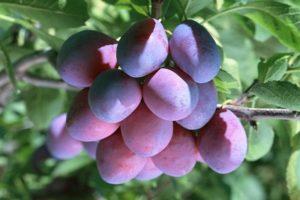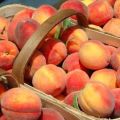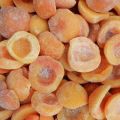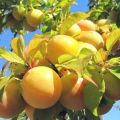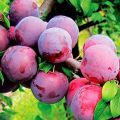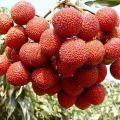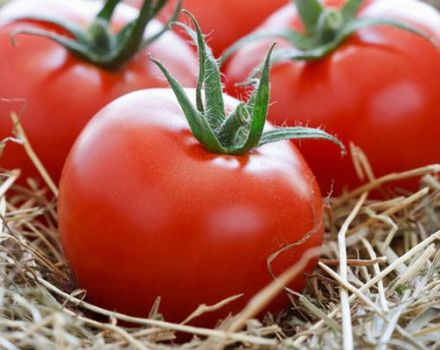Description and characteristics of cherry plum variety Gift to St. Petersburg, planting and care
Cherry plum called Gift to St. Petersburg is a new variety created as a result of hybridization of the Chinese early-growing plum culture and the Pionerka cherry plum. Its advantages are rich productivity and excellent taste. Experienced breeders had a hand in creating a hybrid. The culture is developing well, it is characterized by increased resistance to cold and disease.
Description of the variety
When choosing a variety of cherry plum Gift to St. Petersburg, read its description.
The plant grows up to 2-3 meters, depending on climatic conditions. The culture has a short trunk and a wide, spreading crown of a weeping look. The plate has a polished bright green surface. The shape of the leaves is elongated, with an uneven edge, while curved like a boat.
The hybrid blooms with white saucer flowers. Petals with wavy-cut edges, like those of leaves. Each flower contains a huge number of stamens with anthers of a beautiful golden color. The plant blooms from the beginning of May, and ripening occurs already in August.
The variety was bred for the climatic conditions of the Middle Lane. The plant is patriotically called the Russian plum.
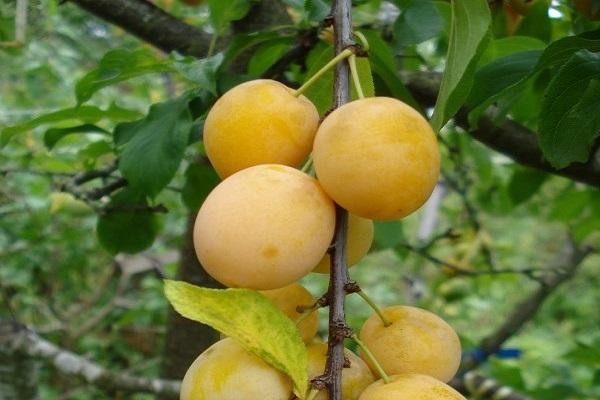
Plant characteristics
The culture begins to bear fruit in the third or fourth year after grafting. It has characteristic qualities that differ from other plants:
- fruiting begins after vaccination in the third year;
- stable harvest;
- huge fruits of amber color;
- universal use of fruits;
- fruits with fine fiber pulp;
- transfers transportation and storage.
From one young plant, you can collect 25-30 kilograms of fruit. Fruits have an elongated ovoid shape weighing 11-13 grams. Moreover, they are quite juicy, sweet, exude a delicate aroma. The stone inside the fruit is slightly pointed and weighs up to 1 gram. The peel is thin, elastic, with a slight waxy bloom.
From a ten-year-old plant, you can harvest up to 60 kilograms. Ripe fruits are prone to shedding, which is why it is not recommended to delay the harvest.
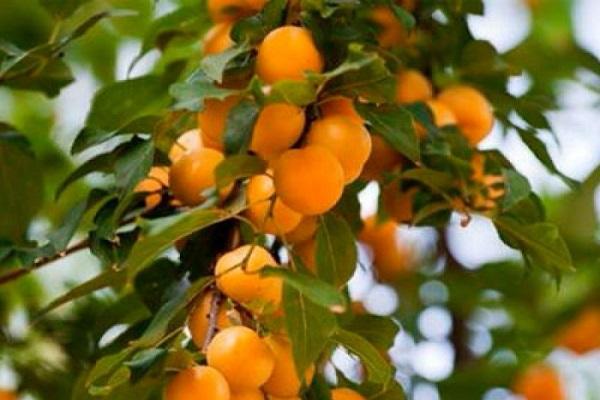
The culture blooms beautifully, so some gardeners prefer the plant as a decorative element in landscaping.
Pros and cons of cherry plum gift to St. Petersburg
The hybrid has a wide range of successful metrics. The breeding process was quite laborious and long, so the plant creates worthy competition even for the best varieties:
- the size of the fruit is larger than that of other crops;
- exquisite fruit taste;
- the first crop can be harvested in the second year after planting;
- undemanding to the soil;
- excellent honey plant;
- the variety practically does not get sick;
- not picky about frequent watering;
- high seed germination;
- tolerates frosty winters well.
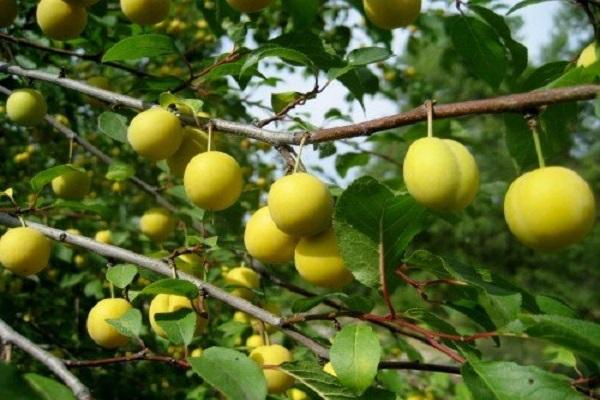
There are much fewer cons, but they are:
- self-fruitless - to get a crop, you need to pollinate;
- the fruit may fall off by itself.
In addition, at the end of winter and at the beginning of spring, there are sharp changes in temperature. This can damage the flower buds of the plant.
Growing rules
Choosing a cherry plum Gift for St. Petersburg, you can be sure that many worries are not expected. The variety is practically not picky about soil conditions and has a high level of survival.
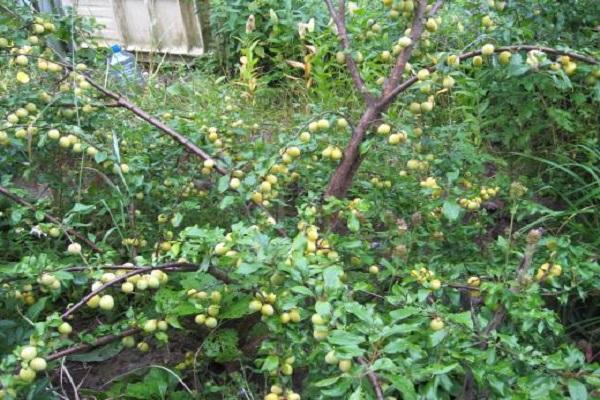
Sapling selection
When choosing a plant, pay attention to a seedling with a well-developed root system. He must meet certain standards:
- one year old;
- smooth bark;
- cut roots are white;
- lack of dry branches and damage;
- the length of the root system is at least 10-15 centimeters;
- lack of dryness in the rhizome.
Important: if there are diseased and damaged roots, they need to be cut off. It is recommended to give preference to seedlings with a closed rhizome.
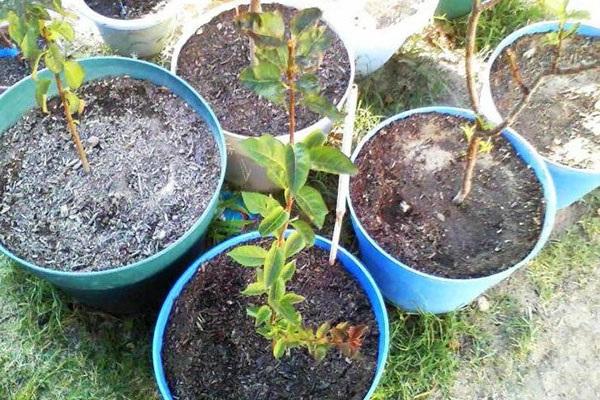
Choosing a landing site
When deciding on a planting site, it should be remembered that the variety does not like shade and drafts. Ideally, the south and southwest sides of the site are suitable. The building will successfully protect the plant from the gusts of icy winds. Loamy soil with neutral acid contributes to good fruiting.
For a hybrid variety it is preferable:
- drained soil;
- stable humidity;
- fertility of the land;
- groundwater flow within a meter.
If planting involves several trees, then place the rows from east to west.
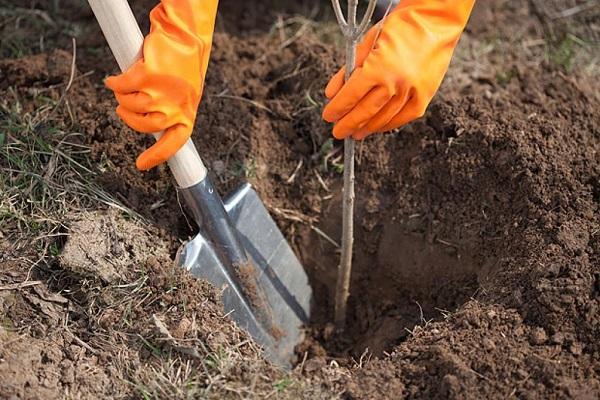
Site preparation
An important point is the preparation of the site. Planting holes, previously dug in the fall or spring, should have a depth of 70 by 70 centimeters. Maintain a distance of at least three meters.
Fill in the holes:
- phosphorus fertilizer;
- potassium sulfide;
- ash;
- compost.
Important: if clay soil predominates, add a couple of buckets of peat or sand.
As a result, the soil will easily allow moisture and air to pass through, which will have a good effect on the survival of the seedling in a new place. Then fill the recesses generously with water.

Step by step process
By following the recommendations, you can safely grow a hybrid. Step-by-step instructions will help the plant to take root well in the soil:
- in the center of the landing pit, prepared in advance, make a mound;
- place the roots of the plant on the tubercle;
- the root collar of the culture should be at the level of the soil surface;
- fill the hole and press down on the ground to improve contact with the rhizome;
- form irrigation holes around the planting.
Drive a stake 1 meter high next to it, to which you subsequently attach the seedling. Planting ends with conscientious watering.
Pollinators
The culture is self-fertile, so additional pollination is indispensable.
The following pollinators are great for fruit production:
- cherry plum variety Pavlovskaya Zheltaya;
- Pchelnikovskaya;
- Seedling Rocket.
Crops are planted from the main hybrid at a distance of 3 meters.
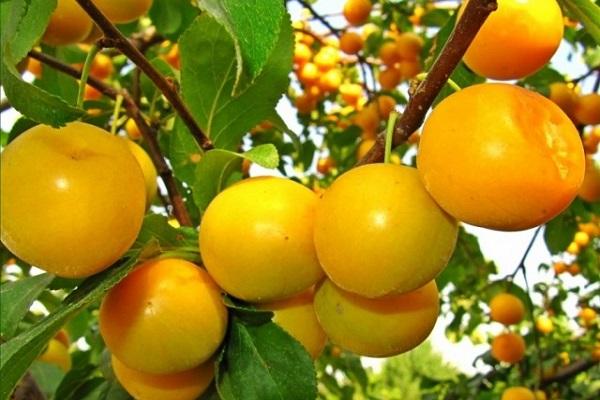
Further care of the culture
The plant requires proper and timely care, which consists of watering, pruning and disease prevention.
Watering and fertilizing
The hybrid is quite moisture-loving, so it needs good hydration. It is enough to water the plant thoroughly every summer month:
- 1st time - after flowering - in June;
- 2nd time - when the stone is formed - in July;
- 3rd time - fruits gain color - in July.
Pour at least five buckets under the plant.
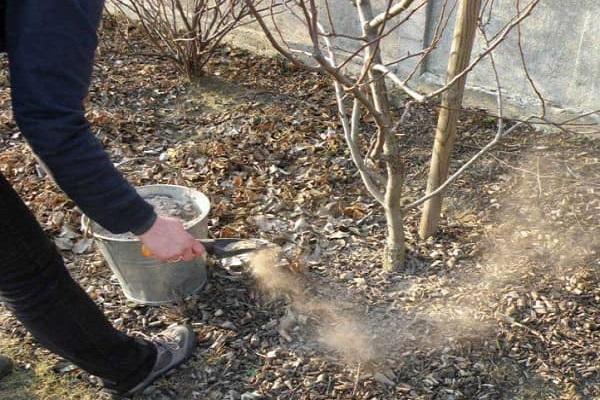
Pruning
After planting the culture, leave five skeletal branches on it. Then shorten them to half a meter and stretch them with ties. In winter, this will help cover the branches with snow, which will save them from freezing. In early summer, it is recommended to shorten the branches by 20 centimeters. This will provoke the appearance of young shoots from the lateral buds, which will bear fruit.
Preparing the plant for winter
In late autumn, whitewash the plant with a lime solution to protect the trunk from rodents. Despite the fact that the variety normally tolerates harsh winters, it is better to cover young plants with special covering material or spruce branches at first. Do not mulch the hole with dry herbaceous plants, as they may contain pests.
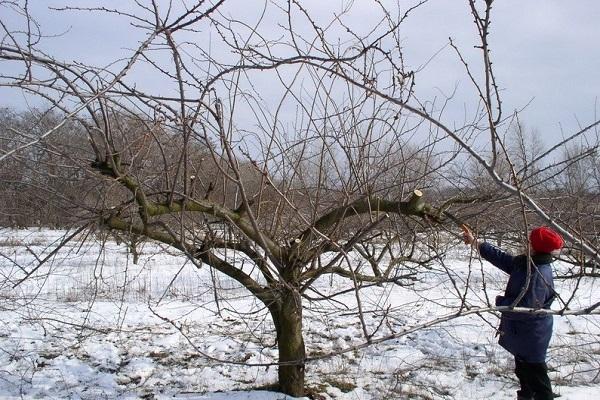
Disease and pest control methods
The hybrid has a large number of pests. The main measures to combat them and diseases include the following activities:
- destroy all plant debris without leaving them in the holes for the winter;
- remove and burn diseased shoots and fruits;
- in case of fungal infections, cut the branches, and treat the cuts with copper sulfate or garden pitch;
- clean the trunk of old dead bark.
Remember to collect and destroy fallen leaves and fruits.
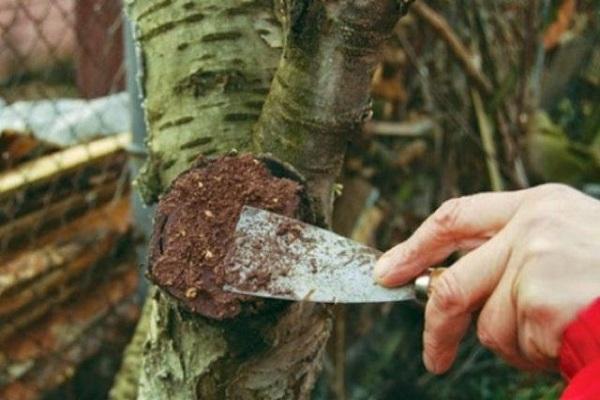
Harvesting and storage of crops
Ripe fruits are harvested in several steps, as they ripen unevenly. To preserve the fruit and not spoil, you need to put it in boxes with air holes.
The crop can be stored for up to three weeks at temperatures up to +5 ° C.
The culture is very popular among gardeners. And this is not only because the plant is unpretentious in care and tolerates winter calmly. The hybrid's fruits are quite tasty and healthy. They make a wonderful dessert fresh and canned.
